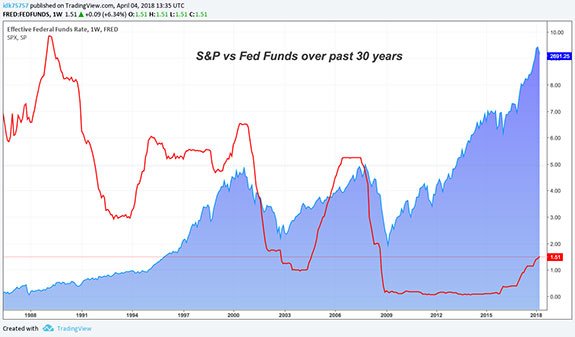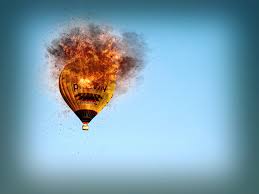The Fed is about to crash the markets again. Mark Twain is reputed to have said: “History doesn’t repeat itself, but it does rhyme.”
If there’s anything here that could be repeating itself, it’s the inability of the tinkering Federal Reserve to get through a rate-hike cycle without significantly impacting the market.
The Fed & The Markets
As we’ve seen from the recent past, the market might not respond immediately. However, the past two rate-hike cycles saw the S&P 500 correct by 50%.
There is a growing concern among investors that newly appointed Fed Chair Jerome Powell and his merry band of central bankers (or banksters, for “end the Fed” types) will put an end to the stock market rally by increasing the fed funds rate. In the U.S., the fed funds rate is the rate that banks lend to one another, and can be looked at as the cost of money.
While not an exact science, interest rates affect the economy by influencing consumer and business spending, and thereby funneling down to changes in stock and bond prices. When interest rates are higher, business and consumers typically save more and spend less, which can be detrimental to economic growth.
In that light, let’s take a look at previous rate-hike cycles to evaluate their impact on stock prices.
Irrational Exuberance
The following chart shows the S&P 500 in blue versus the fed funds rate over the past 30 years.

The first thing to note is that the beginning of the bull market, which has returned over 800% to investors over the past three decades, coincided with a drop in the fed funds rate from 10% in the late ‘80s to 3% in the early ‘90s. The economy was in a deep recession under President George H. Bush, and Alan Greenspan’s Fed was doing its best to cut rates and revive economic growth.
From 1995 to 2000, Greenspan kept the target rate around 5%, and the S&P 500 tripled. Even though he warned of “irrational exuberance” in stock prices in December 1996, he kept rates on hold for half a decade.
May 2000 was the first time the Fed raised rates in that cycle by 50 basis points to slow down an overheating economy.
It may have gone too far, too fast as the ensuing stock market sell-off (and dot-com bust) led to a 50% decline over the next two years.
Related: 3 ETFs to Invest in as the Fed Tighten’s Policy
The Subprime Scare
As the market and the economy bottomed in 2003, the Fed left rates at 1%, fearing an aggressive move would lead to the same outcome as 2000. This easy-money policy was a key factor in the housing bubble of 2004 to 2006, which drove both stock and home prices higher.
Fearing the Fed was behind the curve, Greenspan aggressively raised rates from 1% to 5.25% between 2004 to 2006, and then tossed the keys to Ben Bernanke.
In May 2007, Bernanke said that “the effect of the troubles in the subprime sector … will be limited, and we do not expect significant spillovers from the subprime market to the rest of the economy or to the financial system.”
Only a month later, Bear Stearns was forced to rescue two subprime mortgage funds, and the Fed began lowering rates.

